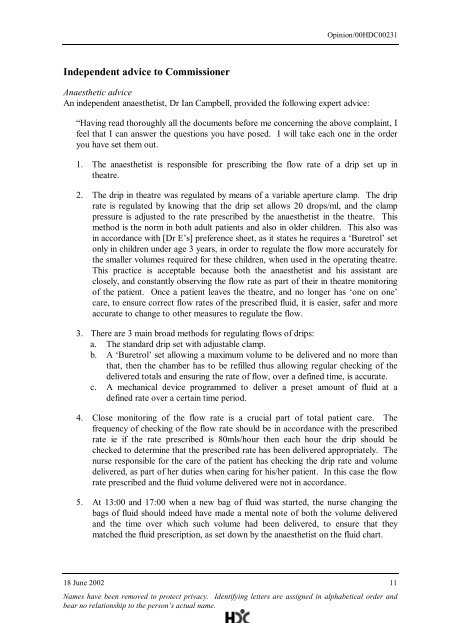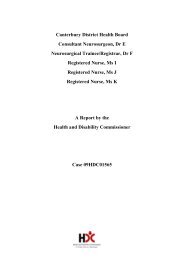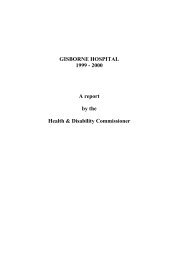Download the pdf version of this decision. - Health and Disability ...
Download the pdf version of this decision. - Health and Disability ...
Download the pdf version of this decision. - Health and Disability ...
Create successful ePaper yourself
Turn your PDF publications into a flip-book with our unique Google optimized e-Paper software.
Opinion/00HDC00231<br />
Independent advice to Commissioner<br />
Anaes<strong>the</strong>tic advice<br />
An independent anaes<strong>the</strong>tist, Dr Ian Campbell, provided <strong>the</strong> following expert advice:<br />
“Having read thoroughly all <strong>the</strong> documents before me concerning <strong>the</strong> above complaint, I<br />
feel that I can answer <strong>the</strong> questions you have posed. I will take each one in <strong>the</strong> order<br />
you have set <strong>the</strong>m out.<br />
1. The anaes<strong>the</strong>tist is responsible for prescribing <strong>the</strong> flow rate <strong>of</strong> a drip set up in<br />
<strong>the</strong>atre.<br />
2. The drip in <strong>the</strong>atre was regulated by means <strong>of</strong> a variable aperture clamp. The drip<br />
rate is regulated by knowing that <strong>the</strong> drip set allows 20 drops/ml, <strong>and</strong> <strong>the</strong> clamp<br />
pressure is adjusted to <strong>the</strong> rate prescribed by <strong>the</strong> anaes<strong>the</strong>tist in <strong>the</strong> <strong>the</strong>atre. This<br />
method is <strong>the</strong> norm in both adult patients <strong>and</strong> also in older children. This also was<br />
in accordance with [Dr E’s] preference sheet, as it states he requires a ‘Buretrol’ set<br />
only in children under age 3 years, in order to regulate <strong>the</strong> flow more accurately for<br />
<strong>the</strong> smaller volumes required for <strong>the</strong>se children, when used in <strong>the</strong> operating <strong>the</strong>atre.<br />
This practice is acceptable because both <strong>the</strong> anaes<strong>the</strong>tist <strong>and</strong> his assistant are<br />
closely, <strong>and</strong> constantly observing <strong>the</strong> flow rate as part <strong>of</strong> <strong>the</strong>ir in <strong>the</strong>atre monitoring<br />
<strong>of</strong> <strong>the</strong> patient. Once a patient leaves <strong>the</strong> <strong>the</strong>atre, <strong>and</strong> no longer has ‘one on one’<br />
care, to ensure correct flow rates <strong>of</strong> <strong>the</strong> prescribed fluid, it is easier, safer <strong>and</strong> more<br />
accurate to change to o<strong>the</strong>r measures to regulate <strong>the</strong> flow.<br />
3. There are 3 main broad methods for regulating flows <strong>of</strong> drips:<br />
a. The st<strong>and</strong>ard drip set with adjustable clamp.<br />
b. A ‘Buretrol’ set allowing a maximum volume to be delivered <strong>and</strong> no more than<br />
that, <strong>the</strong>n <strong>the</strong> chamber has to be refilled thus allowing regular checking <strong>of</strong> <strong>the</strong><br />
delivered totals <strong>and</strong> ensuring <strong>the</strong> rate <strong>of</strong> flow, over a defined time, is accurate.<br />
c. A mechanical device programmed to deliver a preset amount <strong>of</strong> fluid at a<br />
defined rate over a certain time period.<br />
4. Close monitoring <strong>of</strong> <strong>the</strong> flow rate is a crucial part <strong>of</strong> total patient care. The<br />
frequency <strong>of</strong> checking <strong>of</strong> <strong>the</strong> flow rate should be in accordance with <strong>the</strong> prescribed<br />
rate ie if <strong>the</strong> rate prescribed is 80mls/hour <strong>the</strong>n each hour <strong>the</strong> drip should be<br />
checked to determine that <strong>the</strong> prescribed rate has been delivered appropriately. The<br />
nurse responsible for <strong>the</strong> care <strong>of</strong> <strong>the</strong> patient has checking <strong>the</strong> drip rate <strong>and</strong> volume<br />
delivered, as part <strong>of</strong> her duties when caring for his/her patient. In <strong>this</strong> case <strong>the</strong> flow<br />
rate prescribed <strong>and</strong> <strong>the</strong> fluid volume delivered were not in accordance.<br />
5. At 13:00 <strong>and</strong> 17:00 when a new bag <strong>of</strong> fluid was started, <strong>the</strong> nurse changing <strong>the</strong><br />
bags <strong>of</strong> fluid should indeed have made a mental note <strong>of</strong> both <strong>the</strong> volume delivered<br />
<strong>and</strong> <strong>the</strong> time over which such volume had been delivered, to ensure that <strong>the</strong>y<br />
matched <strong>the</strong> fluid prescription, as set down by <strong>the</strong> anaes<strong>the</strong>tist on <strong>the</strong> fluid chart.<br />
18 June 2002 11<br />
Names have been removed to protect privacy. Identifying letters are assigned in alphabetical order <strong>and</strong><br />
bear no relationship to <strong>the</strong> person’s actual name.
















